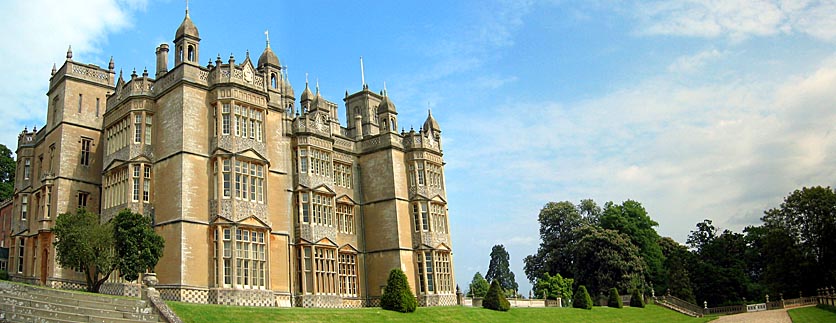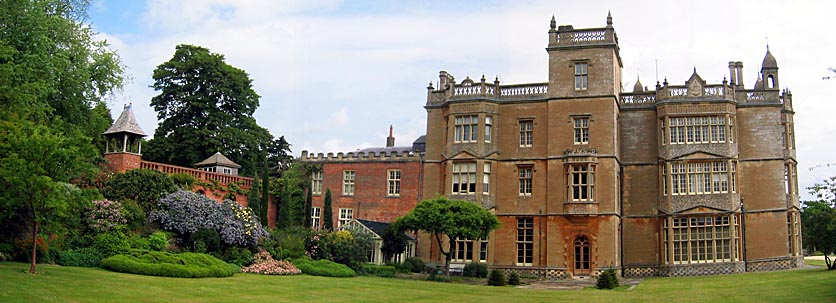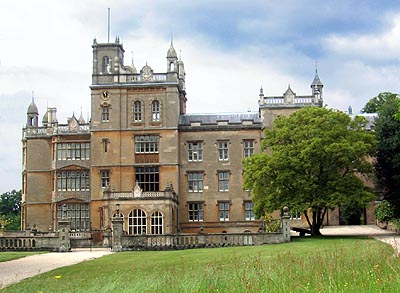 |
 |
|||
|
|
Englefield House Englefield, Berkshire
An approach to Englefield House through the model estate village, passing the church and rectory before coming upon the massively asymmetrical east front, suggests a house newly conceived and executed in the second half of the nineteenth century. In fact, the house's present shape and its decorative components are not so very different from what is seen in John Constable's painting of 1832 or in the background of Powlett Wrighte's portrait of (about) 1775. Englefield is a late Elizabethan E-plan house which has undergone remodelling and refacing in the 18th and 19th centuries without ever suffering a particularly drastic alteration to its basic plan or the style of its external appearance. It still stands within one of the last surviving deer parks in Berkshire. While making repairs to the Long Gallery at Englefield House in 1838, builders are reported to have discovered the date 1558 inscribed on one of the roof timbers. This suggests an addition to the main structure, the basis of which is presumably of pre-Elizabethan date. The ancient Englefield family, who were supposedly lords of the manor since the reign of King Edgar the Peacemaker, in the early 9th century, and knights of the shire in the 14th and 15th centuries, therefore occupied at least part of the present edifice. The last of this ancient line to live at Englefield, was Sir Francis Englefield Senior, a man who attained greater personal distinction than any previous member of the family. He served as sheriff of the county in 1547 and was made a knight of the carpet at the Coronation of King Edward VI. He became one of the chief officers of the household of Princess Mary and was involved in the religious difficulties of the time, being forbidden to allow the celebration of mass in the princess's household. The order of the council was not obeyed and he, with two of his fellow officers, was sent to the Tower in 1551, but their imprisonment was only of short duration. Despite such events, Sir Francis remained, all his life, a firm supporter of the old religion. On the accession of Queen Mary, he was rewarded for his services, being made a privy councillor and master of the Court of Wards and Liveries. Throughout her Catholic reign, he sat in Parliament as one of the knights of the shire for Berkshire. He almost certainly completed the north-east range of Englefield House, including the Long Gallery, at the height of his career, which came abruptly to a close upon the accession of Elizabeth I. Foreseeing the downfall of the old religion, Sir Francis fled from England, in 1559, and lived in exile, at Vallodolid in Spain, for the remainder of his life. The new monarch immediately seized his lands and is said to have granted the use of Englefield to her spymaster-general, Sir Francis Walsingham. He also had a town-house in Reading, on the corner of Broad Street and Minster Street. In spite of protesting to the privy council from abroad, Sir Francis could obtain no redress. So, in 1576, he cleverly presented his estates at Englefield to his protestant nephew and namesake with the right to reclaim them whenever he presented the latter with a gold ring. When the inevitable attainder came, in 1585, it took four years of legal argument and a special Act of Parliament before the manor of Englefield could finally be declared forfeit to the Crown. Sir Francis Englefield Junior bought Whiteknights Park, now Reading University, in 1606 and the family continued to live there, yet were buried in the church at Englefield, until Sir Henry Charles Englefield, Bart., died in 1822 and this branch of the family became extinct. After the attainder of Sir Francis Englefield Senior, in 1585, Queen Elizabeth I leased the manor-house and certain lands there to Humphrey Foster of Aldermaston House and George Fytton for forty years. During the law-suit, this lease was declared void and, in 1589, the same premises were granted to Thomas Crompton, Robert Wright and Gelly Meyrick, acting as trustees for the Queen's favourite, Robert Devereux, the 2nd Earl of Essex. Essex may have purchased the house as part of his bid to win the hand of Sir Francis Walsingham's daughter, Frances, a lady of great beauty and fascination, and the widow of the gallant Sir Philip Sidney. Moreover, if he were rejected, it would still make a fine home for his mother, Lettice Knollys, in the county of her youth. The thought of a return to her own childhood home must have appealed to Lady Sidney though, for the two were married the following year. Essex must have spent large sums on Englefield, for the house's present plan and proportions were probably largely established through his work. After the Earl's fall from grace and subsequent execution in 1601, however, the manor, unfortunately, returned to Royal hands, where it stayed until 1611. In that year, King James I granted it to John Eldred and William Whitmore, who appear to have conveyed it to Thomas Erskine, Viscount Fenton and later Earl of Kellie. Kellie almost certainly bought the place to add to his wife's smaller Englefield estate, centred on the Old Rectory. Along with her first husband, Sir Edward Norreys, she had entertained Queen Elizabeth there in 1601. After the Countess' death in 1621, Lord Kellie sold Englefield to his creditors, Sir Peter Vanlore of Tilehurst and William Rolfe. The latter sold it, in 1623, to Sir John Davies, whose wife, being the Earl's step-daughter, knew the property well. Sir John had been distinguished in politics and letters. He was attorney-general for Ireland and the author of the poem 'Nosce Teipsum,' of a treatise on Ireland and of other works. His wife, however, was somewhat eccentric and, after his death in 1626, was severely punished by the Court of High Commission for the use she made of her prophetical gifts! The manor of Englefield was then settled upon Sir John's daughter, Lucy, wife of Ferdinand, Lord Hastings and later Earl of Huntingdon, but, in 1635, they sold up to John Paulet, the 5th Marquis of Winchester. Only two years before, Lord Winchester had married, as his second wife, Honora, the daughter of the catholic Richard de Burgh, Earl of Clanricarde & St. Albans. Her mother was Frances Walsingham who had electrified the Royal Court by joining the Church of Rome two year's after the execution of her second husband, the Earl of Essex. The Countess had only died a few years before, so it may have been through her influence that Honora persuaded her husband to acquire Englefield House.
The main residence of the Marquis and his family was, however, always the great Tudor palace of Basing House, near Basingstoke in North Hampshire. He is famous for his loyal defence of his home against the armies of Parliament between August 1643 and October 1645, when he was imprisoned in the Tower and Basing razed to the ground. The loss of Basing meant that Englefield became his principle seat after the Restoration of the Monarchy in 1660. He busied himself writing and translating devotional works from the French, and perhaps finding peace there in some way made up for the loss of Basing. During his first three years of residence, however, the 'Loyal Marquis' lost a son, a daughter and his wife Honora. All are buried under black marble slabs in Englefield Church. Nevertheless, his Lordship took Isabella Howard, daughter of the 1st Viscount Stafford, as his third wife and lived for another fifteen years. Englefield was inherited by Lord Francis, the only surviving son of the Marquis' second marriage. He seems to have preferred the spelling of Powlett for the family name, and married Anne Breamore from Tidmarsh, reputed to have been his kitchen maid. Their marriage remained a secret until a manservant, one day, found the meat poorly carved and, not willing to take the blame himself, asked in the kitchen whom he should say was responsible. "You can tell them that Lady Francis Paulet carved the meat," she replied. There is a positive sign that their marriage was a happy one in the hall. The stained glass windows in the entrance show each husbands' coats of arms on the left, with their wives' on the right. As a girl from a poor background, Anne Breamore had no coat of arms and her husband has made her side pure gold which is what she must have been in his eyes. Lord and Lady Francis Powlett had two sons and a daughter. The eldest son, Francis succeeded to Englefield in 1696 and he was probably the one to lay out the formal gardens and a new forecourt. His sister, Anne inherited upon his death in 1712. Anne, married the Reverend Nathaniel Wrighte, son of the Lord Keeper of the Great Seal of England. The other brother is something of a mystery. It is thought that he went to sea and was lost, but a drama that happened one peaceful lunchtime seems to throw doubt on this theory. The story goes that a sea-faring man appeared at the dining-room window and threw a clod of earth through it,, exclaiming that he had come to claim his rightful inheritance. The Reverend Wrighte does not look the sort of man to suffer an interruption of this kind, if his portrait in the house is anything to go by. The sea-faring man, rightful heir or imposter, was sent packing. In 1729, the succession passed to Powlett, the elder of Anne and Nathan's three sons. Powlett Wrighte married Mary Tyssen from Hackney in Surrey, a considerable heiress through her mother, Rachel de Beauvoir. They were responsible for bringing some of the library together. They had one son in 1739 before Powlett's death only two years later. The widowed Mrs. Wright married, as his third wife, Richard Benyon of Gidea Hall in Romford (Essex), a man of obscure origins who had made a £75,000 fortune in the service of the East India Company, latterly as the Governor of Fort St George in Madras. No doubt much of the furniture, cabinets, chests and porcelain which grace the house today were brought back from the East by the Governor. Richard and Mary had one son, also Richard, who married Hannah Hulsein in 1767 and was made heir to Gidea Hall. Mary's elder son, Powlett Wrighte the Younger "reduced and modernised" his house at Englefield, probably in the 1770s. Decorative features of this period survive in the Smoking Room, the Dining Room and the Drawing Room, but the identity of the architect responsible is uncertain. Powlett was on good terms with his half-brother, Richard Benyon the Younger, and may well have used the same craftsmen. Benyon is known to have patronised James Wyatt, who designed the bridge and another building in the park at Gidea. The library ceiling and the idea of an imperial staircase in a plan of Englefield of about 1775 are accomplished enough to make it possible that Wyatt was at least consulted. In 1777, the year of his mother's death, Powlett married, but he died childless, two years later. He left Englefield to his uncle, Nathaniel Wrighte the Younger, for his lifetime and then, on the latter's death in 1789, to his half-brother Richard Benyon. Richard Benyon the Younger died in 1796 and Gidea was sold in 1802, leaving Englefield as the family's principle seat. His son, the third Richard Benyon, took the names of Powlett and Wrighte, in 1814, and of De Beauvoir in 1822, a year after the death of his first cousin twice removed, the Reverend Peter De Beauvoir. Richard Benyon De Beauvoir was heir, not only to the Englefield rents, but also to his grandfather's East India fortune and, through his grandmother, to the de Beauvoir estates at Downham in Essex and Hackney. In addition, he married Elizabeth, the daughter of Sir Francis Sykes, another wealthy nabob and the builder of neighbouring Basildon Park. His multiple fortune, thus enabled Richard to engage Thomas Hopper to undertake substantial work at Englefield House. In his first letter of January 1823, he provided a pencil sketch of the south-west corner of the house, showing the addition of the two bay windows which now light the Drawing Room and the rooms above it. These windows repeated the proportions and decorations of the Elizabethan central porch bay and were also added to the Dining Room on the south-east corner. Hopper finally added a number of tall square turrets, many of them disguising chimneystacks, and work was complete by 1829. On Benyon De Beauvoir's death, in 1854, Englefield passed to his nephew Richard Fellowes, second son of his sister Emma, on condition that he took the name Benyon. Emma Fellowes' three sons were, with reason, known as the 'Lucky Fellowes'. Edward, created Lord De Ramsey in 1887, inherited his father's extensive properties in Huntingdon and Norfolk; Richard succeeded his uncle to Englefield and the London and Essex properties; while the third son, James, came into Kingston Maurward in Dorset on his marriage to Charlotte Micklethwaite.
Marion Benyon, the eldest of Richard Fellowes Benyon's daughters, married Sir John Shelley, 9th Baronet. However, upon Benyon's death in 1897, Englefield was entailed to heirs male and passed to his nephew James Herbert Fellowes of Kingston Maurward, who also changed his name to Benyon. He was made the first Chancellor of Reading University in 1926 and, in 1935, was succeeded by his son, Henry, who became Lord Lieutenant of Berkshire and was created a Baronet. Sir Henry Benyon in turn died childless leaving Englefield to his second cousin Admiral Richard Shelley, younger son of John and Marion Shelley. Admiral Shelley took the name Benyon and, upon his death in 1967, the property came to his eldest son, William, elected MP for Buckingham in 1970. He has reopened of the entrance archway and the demolished the old kitchen in the courtyard behind the house in 1972. These are the only major changes to the house since Victorian times. Partly Edited from a number of old guidebooks. Englefield House is a private residence, with Conference Facilities available. It is easily seen next to the parish church. The gardens are open to the public every Monday throughout the year.
|
|||
| © Nash Ford Publishing 2001. All Rights Reserved. | ||||





 Richard
Fellowes Benyon was philanthropic on a grand scale and fascinated by
agricultural economics. Causes close to his heart in 1862 included the
Mendicity Society, the National Society for School Furniture, the building
of the Albert Memorial and the Society for the Augmentation of Small
Livings. We are told that he gave 'penny-readings' in the school and is
reported to have read 'Pickwick Papers' to a packed audience. He also loved
Englefield and made extensive and sympathetic alterations to the House, some
after a bad fire. In 1856, he wrote to a friend, "I have really begun
in earnest to pull the house at Englefield about my ears and I intend to be
able to get into it again in 16 months". Despite the fact that the
south front was almost entirely refaced, Benyon was careful to preserve the
Elizabethan shell-headed niches and bands of flintwork. Hopper's low
castellations and square turrets were replaced by a much higher balustrade,
breaking boldly out over the bay windows and a series of six open cupolas at
the corners. On the west front, an oriel window and a new bay window were
added and the upper storey of the tower heightened. Much more substantial
alterations were made on the east side, where the old staircase tower was
widened and greatly heightened to make a stately new two storey hall and
a port-cochère. The total
coast was £2,556
17s. It is most likely that
Benyon's architect was Richard Armstrong, whose watercolour of the house was
exhibited at the Royal Academy in 1873. His building programme extended
to the
Richard
Fellowes Benyon was philanthropic on a grand scale and fascinated by
agricultural economics. Causes close to his heart in 1862 included the
Mendicity Society, the National Society for School Furniture, the building
of the Albert Memorial and the Society for the Augmentation of Small
Livings. We are told that he gave 'penny-readings' in the school and is
reported to have read 'Pickwick Papers' to a packed audience. He also loved
Englefield and made extensive and sympathetic alterations to the House, some
after a bad fire. In 1856, he wrote to a friend, "I have really begun
in earnest to pull the house at Englefield about my ears and I intend to be
able to get into it again in 16 months". Despite the fact that the
south front was almost entirely refaced, Benyon was careful to preserve the
Elizabethan shell-headed niches and bands of flintwork. Hopper's low
castellations and square turrets were replaced by a much higher balustrade,
breaking boldly out over the bay windows and a series of six open cupolas at
the corners. On the west front, an oriel window and a new bay window were
added and the upper storey of the tower heightened. Much more substantial
alterations were made on the east side, where the old staircase tower was
widened and greatly heightened to make a stately new two storey hall and
a port-cochère. The total
coast was £2,556
17s. It is most likely that
Benyon's architect was Richard Armstrong, whose watercolour of the house was
exhibited at the Royal Academy in 1873. His building programme extended
to the